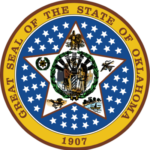Oklahoma
Oklahoma is a state located in the South Central United States. It is bordered to the west by Texas and New Mexico, the north by Colorado and Kansas, the east by Arkansas, and the south by Texas.
- ABBREVIATION: OK
- NICKNAME: The Sooner State
- POPULATION: 3,850,568 (2013 est.)
- CAPITAL: Oklahoma City
- STATE BIRD: Scissor-Tailed Flycatcher
- STATE FLOWER: Mistletoe
- AREA: 69,898 sq. mi.
- TIME ZONE: Central, with Kenton (unofficially): Mountain
- ENTERED UNION: Nov. 16, 1907
- ALTITUDE: High, 4,975 ft. Black Mesa
- CLIMATE: Generally mild winters, hot summers, with great temperature fluctuations. Dry in the west.


Here the grassy lowlands of the central United States fade imperceptibly into the dry Great Plains of the West. In the eastern part of the state, the moist winds of the Gulf of Mexico, rising and cooling as they meet cold air from the northwest, drop sufficient rainfall to permit Oklahoma farmers to grow cotton, fruit, nuts, and the grain crops typical of the Midwest. But west of the 100th meridian, where the Gulf’s humid winds seldom blow, rainfall gradually diminishes. There, even though men have learned to raise winter wheat on the dry land, cattle ranching remains predominant.
Farming on these plains is risky business. In the years when rain is plentiful, the land can be bountiful. But in the 1930’s, when poor farming practices combined with the sun and the wind to destroy the topsoil, the heavily mortgaged Oklahoma farmers packed up and headed toward California, giving their name-“Okies”-to a generation of westward-bound migrants.

On the searing plains of Oklahoma, which were spurned by white men as seemingly worthless, Indian tribes were forcibly resettled in the early 1800’s, with President Jackson promising a peaceful existence to the Indians in a letter with the statement “their white brethren will not trouble them”…”while grass should grow or waters run”. This sentiment is badly contradicted by the way in which the US government actually treated the Indians. Ironically, the land the U.S. government assigned to the red man was to prove among the nation’s richest in oil reserves. Eventually, the Indians would be forced to make new treaties, taking away some of the land and leaving them with smaller and smaller areas on which to live.
FUN FACTS:
- The country’s first parking meters were installed in Oklahoma City in 1935.
- Oklahoma has had 14 official flags during its history.
- The state capitol building in Oklahoma City has a working oil well on its grounds.
- Oklahoma has more artificial lakes than any other state, with over one million surface acres of water.
- Until statehood, Oklahoma was known as Indian Territory. Today 39 tribes have their headquarters in the state.
- The state of Oklahoma was opened to settlers in a “Land Rush” in 1889. Prospective settlers claimed plots of land by outlining their territory with stakes. A few of these settlers laid stakes prior to the official start of the land run and were later known as the “Sooners”.
